Kyushu University
Kyushu University (九州大学, Kyūshū Daigaku), abbreviated to Kyudai (九大, Kyūdai), is a Japanese national university located in Fukuoka, on the island of Kyushu.
九州大学 | |
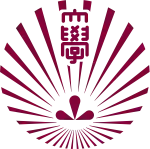 | |
Former names | Kyushu Imperial University |
|---|---|
Motto in English | Opening the Door to a New Century of Knowledge |
| Type | Public (National) |
| Established | Founded 1903, Chartered 1911 |
| Affiliation | Alliance of Asian Liberal Arts Universities |
| Endowment | $72 Million |
| Budget | $1.445 Billion |
| President | Tatsuro Ishibashi |
Academic staff | 2,110 (As of May 1, 2021)[1] |
Administrative staff | 2,351 (As of May 1, 2020)[2] |
| Students | 18,560 (As of May 1, 2022) |
| Undergraduates | 11,683[3] |
| Postgraduates | 6,877[4] |
| Location | , , Japan |
| Campus | Urban, (2.4 km²) Ito, urban, (0.4 km²) Hakozaki, urban, (0.3 km²) Maidashi, urban, (0.25 km²) Chikushi, urban, (0.063km²) Ohashi, rural, (0.1 km²) Beppu, Research Forests and Farms (72 km²) |
| Language | Japanese and English |
| Colours | Wine Red |
| Website | www |
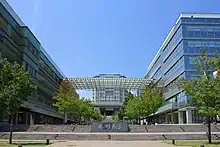
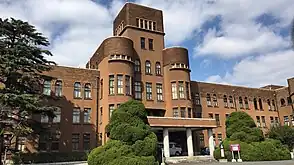

It was the 4th Imperial University in Japan, ranked as 6th in the 2020 Times Higher Education Japan University Rankings,[5] one of the top 10 Designated National University and selected as a Top Type university of Top Global University Project by the Japanese government. Kyudai is considered one of Japan's most prestigious research-oriented universities and is a member of the Alliance of Asian Liberal Arts Universities along with the University of Tokyo, Waseda University, Peking University and others.
The history of Kyushu University can be traced back to the medical schools of the Fukuoka Domain (福岡藩 Fukuoka han) established in 1867. The school was reorganized into Fukuoka Medical College of Kyoto Imperial University in 1903. It became independent as Kyushu Imperial University in 1911. Albert Einstein visited the university on December 25, 1922.[6]
There are 2,089 foreign students (As of 2016) enrolled in the university. It was chosen for the Global 30 university program, and has been selected to the top 13 global university project.[7]
Symbol
Kyushu University does not have an official school song, instead, it has one cheering song and three student songs including Matssubara-ni, with lyrics by Yoshifumi Akiyama.
The university's logo features a background of pine needles inset with an older iterance of the kanji for "university". The logo was officially established in 2004, but was originally proposed by a student, Sou Yoshihide, in the mid-20th century, and was used then on from 1950. There have also been alternatives designs, such as those featuring the Japanese KU or Q, for Kyushu instead of "university".
Global 30 Project
On July 3, 2009, Kyushu University was chosen for the “Global 30 (G30) Project”.[8]
Kyushu University Hospital
History
Kyushu University is one of the seven former Imperial Universities created in the Meiji period. The university is the largest research university in the Kyushu region with research centers in eleven different academic faculties, including the humanities, social sciences, medicine, and science.
Kyushu University Hospital is affiliated with the Faculty of Medical Sciences, the Faculty of Dental Science, and the Faculty of Pharmaceutical Sciences.
- 1867: The Kuroda Clan establishes an institution for Western medicine (Sanseikan) for the children of the lord and their retainers. The roots of present-day Kyushu University Hospital can be traced back to the clinic affiliated with that school.
- 1879: At the beginning of the Meiji period the clinic becomes an affiliated hospital of Fukuoka Prefectural Medical School.
- 1903: Fukuoka Medical College, a branch school of Kyoto Imperial University is established, and the hospital becomes affiliated with that school.
- 1911: Kyushu Imperial University is established in Fukuoka, and this hospital becomes affiliated with the university's Faculty of Medicine.
- 1931: The Research Institute of Balneotherapeutics is established in Beppu, Ōita Prefecture.
- 1947: Following the university reform that took place after World War II, the hospital's name was changed to the Kyushu University Faculty of Medical Sciences Affiliated Hospital. Fifteen departments, including a dental department, were established.
- 1967: The Faculty of Dental Science becomes an independent facility. The Faculty of Dental Science Affiliated Hospital opens.
- 2002: The new master plan for Ito campus was designed by César Pelli, Kisho Kurokawa (黒川紀章).
- 2003: The three hospitals affiliated with Faculty of Medical Sciences, Faculty of Dental Science and Medical Institute of Bioregulation merge to form Kyushu University Hospital.
- 2009: Plans for the construction of a new hospital, which began in 2000, are completed. The new hospital consists of a South Ward, North Ward, West Ward and Outpatient Ward.
War Crimes
- 1945: Surviving crewmen from a downed American B-29 were subjected to fatal medical experiments and vivisection conducted by members of the university's medical faculty.[11] While still alive, the POWs were vivisected, portions of their vital organs were removed, holes were drilled into their skulls and sea water was pumped into their bloodstreams. None of the POWs survived the experiments. Members of the faculty and administration were later tried and convicted of war crimes.[12][13][14]
Academic rankings
| T. Reuters National[15] | Research | 6 | |
|---|---|---|---|
| NBP Kyushu/Okinawa/Yamaguchi[16] | Reputation | 1 | |
| Shimano National[17] | Selectivity | SA | |
| QS Asia (Asian Ranking version)[18] | General | 18 | |
| ARWU Asia[19] | Research | 19-26 | |
| THE World[20] | General | 401-500 | |
| QS World[21] | General | 126 | |
| ARWU World[19] | Research | 151-200 | |
| ENSMP World[22] | Alumni | 38 | |
| Social Sciences & Humanities | |||
|---|---|---|---|
LAW | |||
| Natural Sciences & Technology | |||
Engineering | |||
MATERIALS SCIENCE | |||
| T.Reuters National[23] | Research | 6 | |
| T.Reuters World[23] | Research | 49 | |
CHEMISTRY | |||
| T.Reuters National[23] | Research | 6 | |
| T.Reuters World[23] | Research | 41 | |
BIOLOGY & BIOCHEMISTRY | |||
| T.Reuters National[23] | Research | 4 | |
| T.Reuters World[23] | Research | 95 | |
| Life Sciences | |||
IMMUNOLOGY | |||
| T.Reuters National[23] | Research | 4 | |
| T.Reuters World[23] | Research | 68 | |
PHARMACOLOGY & TOXICOLOGY | |||
| T.Reuters National[23] | Research | 4 | |
| T.Reuters World[23] | Research | 76 | |
| * T. Reuters World rankings include non-educational institutions | |||
General rankings
The university has been ranked 5th in the 2020 Times Higher Education Japan University Rankings,[5] which is one rank down from 2019.[24] In another ranking, Japanese prep school Kawaijuku ranked Kyushu as the 7th best university in Japan.[25]
It has been ranked 132nd in the 2020 QS World University Rankings,[26] and 401-500th in the Times Higher Education World University Rankings.[27]
According to QS, its subject rankings were: 123rd in Engineering & IT, 170th in Life Sciences & Biomedicine, and 150th in Natural Sciences. It is also the 18th best university in Asia, according to QS Asian University rankings.[28]
Research performance
Kyushu is one of the top research institutions in Japan. According to Thomson Reuters, Kyushu is the 6th best research university in Japan.[15] Its research excellence is especially distinctive in Materials Science (6th in Japan, 49th in the world), Chemistry (6th in Japan, 41st in the world), Biology & Biochemistry (4th in Japan, 95th in the world), Immunology (4th in Japan, 68th in the world), and Pharmacology & Toxicology (4th in Japan, 76th in the world).[29]
Weekly Diamond reported that Kyushu has the 16th highest research standard in Japan in terms of research funding per researchers in COE Program.[30] In the same article, it is also ranked fifth in terms of the quality of education by GP funds per student.
Furthermore, Nikkei Shimbun on 2004/2/16 surveyed about the research standards in Engineering studies based on Thomson Reuters, Grants in Aid for Scientific Research and questionnaires to heads of 93 leading Japanese Research Centers, and Kyushu was placed 11th (research planning ability 10th) in this ranking.[31]
Graduate school rankings
Eduniversal ranked Kyushu as 9th in the rankings of "Excellent Business Schools nationally strong and/or with continental links " in Japan.[32]
Kyushu was ranked 12th in the number of successful candidates of the Japanese Bar Examination in 2009 and 15th in 2010 in Japan.[33]
Alumni rankings
According to the Weekly Economist's 2010 rankings, graduates from Kyushu have the 53rd best employment rate in 400 major companies in Japan.[34]
École des Mines de Paris ranks Kyushu University as 38th in the world in 2011 in terms of the number of alumni listed among CEOs in the 500 largest worldwide companies.[22]
Popularity and selectivity
Kyushu is one of the most selective universities in Japan. Its entrance difficulty is usually considered one of the top in Japan.[35][36]
Scholarships for international students
Kyushu offers a number of selected scholarships for international students. Some of them are:[37]
- Topia Leisure Scholarship (scholarship with work experience)
- JASSO - Encourage privately financed international students learning costs
- Fukuoka International Student Scholarship
- Ushio Foundation Scholarship
- Ajinomoto Scholarship
- Sun Noh Scholarship
Evaluation from Business World
| Ranking | |
|---|---|
| all universities in Japan | 8th[38] out of all 744[39] universities which existed as of 2006 |
| Source | 2006 Survey[38] by Weekly Diamond 〈ja〉 on the ranking of the universities which produced the high percentage of the graduates who hold the position of "president and chief executive officer of listed company" to all graduates of each university |
| Ranking | |
|---|---|
| all universities in Japan | 15th[40] out of all the 778[41] universities which existed as of 2010 |
| Source | 2010 Survey[40] by Weekly Economist 〈ja〉 on the ranking of universities according to the ratio of the number of the officers & managers produced by each university to the number of graduates |
| Ranking | |
|---|---|
| Japan | 8th[42] (out of 781[43] universities in Japan as of 2020) |
| Source | 2020 Nikkei Survey[44] to all listed (3,714[45]) and leading unlisted (1,100), totally 4,814 companies[44] |
Notable people associated with Kyushu University
Chemistry, Physics and Engineering
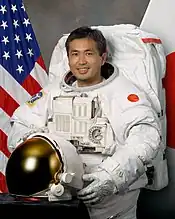 Koichi Wakata (若田 光一) PhD, cosmonaut, the first Japanese commander of the International Space Station.
Koichi Wakata (若田 光一) PhD, cosmonaut, the first Japanese commander of the International Space Station.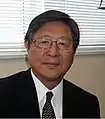 Toyoki Kunitake (國武 豐喜), chemist and materials scientist, 2015 Kyoto Prize winner.
Toyoki Kunitake (國武 豐喜), chemist and materials scientist, 2015 Kyoto Prize winner.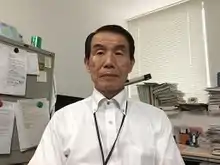 Seiji Shinkai (新海 征治), pioneer in molecular self-assembly, but missed out on the 2016 Nobel Prize in Chemistry.
Seiji Shinkai (新海 征治), pioneer in molecular self-assembly, but missed out on the 2016 Nobel Prize in Chemistry.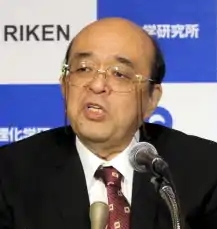 Kōsuke Morita (森田 浩介), experimental nuclear physicist, known as the leader of the Japanese team that discovered element 113.
Kōsuke Morita (森田 浩介), experimental nuclear physicist, known as the leader of the Japanese team that discovered element 113.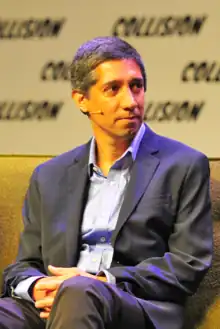
- Kyozi Kawasaki (川崎 恭治), physicist, 2001 Boltzmann Medal winner.
- Genichi Taguchi (田口 玄一), engineer and statistician.
- Heitaro Nakajima, (中島 平太郎), digital audio pioneer, president Aiwa
Physiology or Medicine
 Ryukichi Inada (稲田 龍吉), physician, 1919 Nobel Prize in Physiology or Medicine nominee.
Ryukichi Inada (稲田 龍吉), physician, 1919 Nobel Prize in Physiology or Medicine nominee.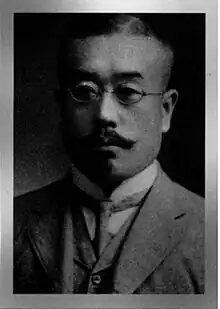 Fujiro Katsurada (桂田 富士郎), a parasitologist who discovered a parasite called Schistosoma japonicum.
Fujiro Katsurada (桂田 富士郎), a parasitologist who discovered a parasite called Schistosoma japonicum.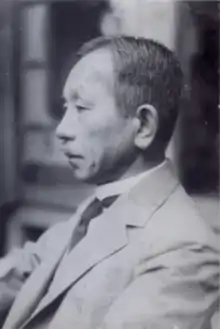 Sunao Tawara (田原 淳), a pathologist who discovered the atrioventricular node (Node of Tawara)
Sunao Tawara (田原 淳), a pathologist who discovered the atrioventricular node (Node of Tawara) Tetsu Nakamura (中村 哲), physician, headed Peace Japan Medical Services (PMS), 2003 Ramon Magsaysay Award winner.
Tetsu Nakamura (中村 哲), physician, headed Peace Japan Medical Services (PMS), 2003 Ramon Magsaysay Award winner.
- Inokichi Kubo (久保 猪之吉), pioneer of otorhinolaryngology.
- Ōmori Harutoyo (大森 治豊), surgeon and first president of the Fukuoka Medical College.
- Yutaka Ido (井戸 泰), surgeon, 1919 Nobel Prize in Physiology or Medicine nominee.
- Naosuke Onodera (小野寺 直助), surgeon, 1937 Nobel Prize in Physiology or Medicine nominee.
- Kazuo Yamafuji (山藤 一雄), scientist, 1964 Nobel Prize in Physiology or Medicine nominee.
- Hakaru Hashimoto (橋本 策), MD, PhD, medical scientist, discoverer of Hashimoto's thyroiditis.
- Masatoshi Nei (根井 正利), a Japanese-born American evolutionary biologist, 2013 Kyoto Prize winner.
- Yoshizumi Ishino (石野 良純), molecular biologist, known for his discovering the DNA sequence of CRISPR.
- Takehiko Sasazuki (笹月 健彦) MD, PhD emeritus professor, professor of Kyushu University Institute for Advanced Study (高等研究院)[46]
Literature and History
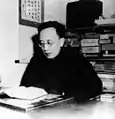 Guo Moruo (郭沫若), a Chinese archaeologist, historian, poet, politician, and writer.
Guo Moruo (郭沫若), a Chinese archaeologist, historian, poet, politician, and writer. Yasushi Inoue (井上 靖), drop out, a Japanese writer, 1950 Akutagawa Prize winner and Nobel Prize in Literature nominee.[47]
Yasushi Inoue (井上 靖), drop out, a Japanese writer, 1950 Akutagawa Prize winner and Nobel Prize in Literature nominee.[47] Junzo Shono(庄野 潤三), a Japanese novelist, Akutagawa award winner
Junzo Shono(庄野 潤三), a Japanese novelist, Akutagawa award winner
- Junzo Shono (庄野 潤三), a Japanese novelist, 1954 Akutagawa Prize winner.
- Toshio Shimao (島尾 敏雄), a Japanese novelist, 1977 Yomiuri Prize winner.
- Kyoichi Katayama (片山 恭一), a Japanese author.
- Rizō Takeuchi (竹內 理三), historian
- Wolfgang Michel-Zaitsu, historian, first foreigner granted a tenure at a Japanese national university in 1984.
- Hsu Hsing-Ching (徐興慶), president of Chinese Culture University in Taiwan.
- Yasuhisa Hara (原 泰久), a Japanese cartoonist.
- Kyojin Onishi(大西巨人), a Japanese novelist, Malxist
Politics and Business
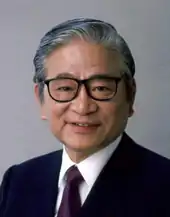 Shozaburo Jimi (自見 庄三郎) MD, PhD, Minister of Posts and Telecommunications
Shozaburo Jimi (自見 庄三郎) MD, PhD, Minister of Posts and Telecommunications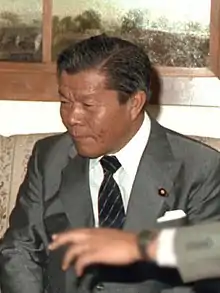
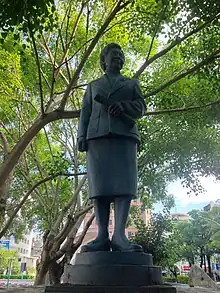 Hsu Shih-hsien (許世賢), a Taiwanese academic and politician, the first Taiwanese woman to earn a doctorate.
Hsu Shih-hsien (許世賢), a Taiwanese academic and politician, the first Taiwanese woman to earn a doctorate. Tomihisa Taue (田上 富久), mayor of Nagasaki.
Tomihisa Taue (田上 富久), mayor of Nagasaki.
- Shinya Izumi(泉 信也) Politician
- Robert T. Huang, SYNNEX Corporation founder
See also
References
- At a Glance Fast Facts 2021-2022 (PDF). Kyushu University. p. 3.
- "教職員数" (PDF). Kyushu University.(in Japanese) Including 1,182 hospital staff
- "学生現員数(学部生)" (PDF). Kyushu University. May 1, 2022.(in Japanese)
- "学生現員数(大学院生)" (PDF). Kyushu University. May 1, 2022.(in Japanese)
- "Japan University Rankings 2020". Times Higher Education (THE). 2020-05-30. Retrieved 2020-05-30.
- 九州大学物理学教室企画・主催 (2005-09-10). "世界物理年2005記念イベント 子どももおとなも楽しめるアインシュタインの宇宙". 九州大学物理学教室. Archived from the original on 2007-08-14. Retrieved 2012-05-01.
- "Selection for the FY 2014 Top Global University Project" (PDF). MEXT.
- "Archived copy" (PDF). Archived from the original (PDF) on 2016-03-05. Retrieved 2016-02-22.
{{cite web}}: CS1 maint: archived copy as title (link) - "Kyushu University "Japan in Today's World" Program". www.isc.kyushu-u.ac.jp. Retrieved 2016-02-22.
- "ASEAN International Education Programme". www.isc.kyushu-u.ac.jp. Retrieved 2016-02-22.
- McCurry, Justin (2015-08-13). "Japan revisits its darkest moments where American POWs became human experiments". The Guardian. ISSN 0261-3077. Retrieved 2019-02-13.
- "Japan revisits its darkest moments where American POWs became human experiments". TheGuardian.com. 13 August 2015.
- "WWII prisoners of war used for live experiments in Japan had parts of their brains cut out". Independent.co.uk. 7 April 2015.
- "New Kyushu museum breaks taboo with POW vivisection display". 4 April 2015.
- "Thomson Reuters 20 Top research institutions in Japan". Thomson Reuters. 2011. Retrieved July 22, 2022. (this raking includes 5 non-educational institutions)
- "Nikkei BP Brand rankings of Japanese universities" (in Japanese). Nikkei Business Publications. 2010. Retrieved April 29, 2011.
- "GBUDU University Rankings" (in Japanese). YELL books. 2009. Retrieved April 29, 2011.
- "QS Asian University Rankings". QS Quacquarelli Symonds Limited. 2016. Retrieved September 24, 2017.
- "Academic Ranking of World Universities". Institute of Higher Education, Shanghai Jiao Tong University. 2017. Retrieved September 24, 2017.
- "THE World University Rankings". Times Higher Education. 2018. Retrieved September 24, 2017.
- "QS World University Rankings". QS Quacquarelli Symonds Limited. 2018. Retrieved September 24, 2017.
- "ENSMP World University Rankings" (PDF). École nationale supérieure des mines de Paris. 2011. Retrieved April 29, 2011.
- "Thomson Reuters 10 Top research institutions by subject in Japan" (in Japanese). Thomson Reuters. 2010. Retrieved May 11, 2011.
- "Japan University Rankings 2019". Times Higher Education (THE). 2020-05-30. Retrieved 2020-05-30.
- "Kawai 30 Top Japanese Universities". Kawaijuku. 2001. Retrieved April 29, 2011.
- "QS World University Rankings 2020: Top Global Universities | Top Universities". Top Universities. 2020-03-18. Retrieved 2020-03-18.
- "World University Rankings". Times Higher Education (THE). 2017-08-18. Retrieved 2019-05-14.
- "QS University Rankings: Asia - 2011". Top Universities. 2012-12-19. Retrieved 2013-11-08.
- "Thomson Reuters 20 Top research institutions in Japan" (in Japanese). Thomson Reuters. Archived from the original on 2011-06-13. (this ranking includes non-educational institutions)
- "週刊ダイヤモンド" ダイヤモンド社 2010/2/27 http://web.sapmed.ac.jp/kikaku/infomation/0227daiyamondokiji.pdf
- "大学工学部研究力調査(04.2.22)". Homepage3.nifty.com. Archived from the original on 2015-05-07. Retrieved 2013-11-08.
- "University and business school ranking in Japan". Eduniversal-ranking.com. Retrieved 2013-11-08.
- "2010年(平成22年)新司法試験法科大学院別合格率ランキング -法科大学院seek". Laws.shikakuseek.com. Retrieved 2013-11-08.
- "Employment rate in 400 major companies rankings" (in Japanese). Weekly Economist. 2011. Retrieved Apr 29, 2011.
- e.g. Yoyogi seminar published Hensachi (the indication showing the entrance difficulties by prep schools) rankings "Archived copy". Archived from the original on 2011-04-22. Retrieved 2016-07-29.
{{cite web}}: CS1 maint: archived copy as title (link) - Japanese journalist Kiyoshi Shimano ranks Kyushu's entrance difficulty as SA (most selective/out of 11 scales) in Japan. 危ない大学・消える大学 2012年版 (in Japanese). YELL books. 2011. ASIN 4753930181.
- Kyushu Scholarships for International Students
- Weekly Diamond The ranking of the universities which produced the high percentage of the graduates who hold the position of "president and chief executive officer of listed company" to all graduates of each university(in Japanese)
- The number of universities and students|National Universities Association Archived 2020-11-01 at the Wayback Machine(in Japanese)
- Is it a story of the past that graduates from famous universities can easily move up the career ladder? / RECRUIT AGENT(in Japanese)
- University reform reference materials / Cabinet Secretariat(in Japanese)
- Survey on the image seen from human resources personnel:Ranking of the ability to get jobs|Nikkei HR 2020.06.03 release
- "The number of universities in Japan is 781 as of April 1, 2020. About 80% are private universities.|Ōbun Sha" (PDF). Archived from the original (PDF) on January 30, 2021. Retrieved February 11, 2021.
- Image held by human resources personnel of companies of Japan / Yokohama National University ranked 1st in Kantō & Kōshin'etsu region / Valuation from the ex-students already employed / The Nikkei・Nikkei HR Survey 2020-06-04 17:27
- Number of listed companies & listed shares of stock|JPX
- 九州大学高等研究院・組織・メンバー Archived 2014-11-29 at the Wayback Machine (in Japanese)
- 安部公房は受賞寸前だった…ノーベル委員長語る YOMIURI ONLINE2012年3月23日